Page 8 of 466
Table of
ContentsIllustrated table of contents
Safety—Seats, seat belts and supplemental restraint system
Instruments and controls
Pre-driving checks and adjustments
Monitor, climate, audio, phone and voice recognition systems
Starting and driving
In case of emergency
Appearance and care
Maintenance and do-it-yourself
Technical and consumer information
Index
0
1
2
3
4
5
6
7
8
9
10
Page 21 of 466
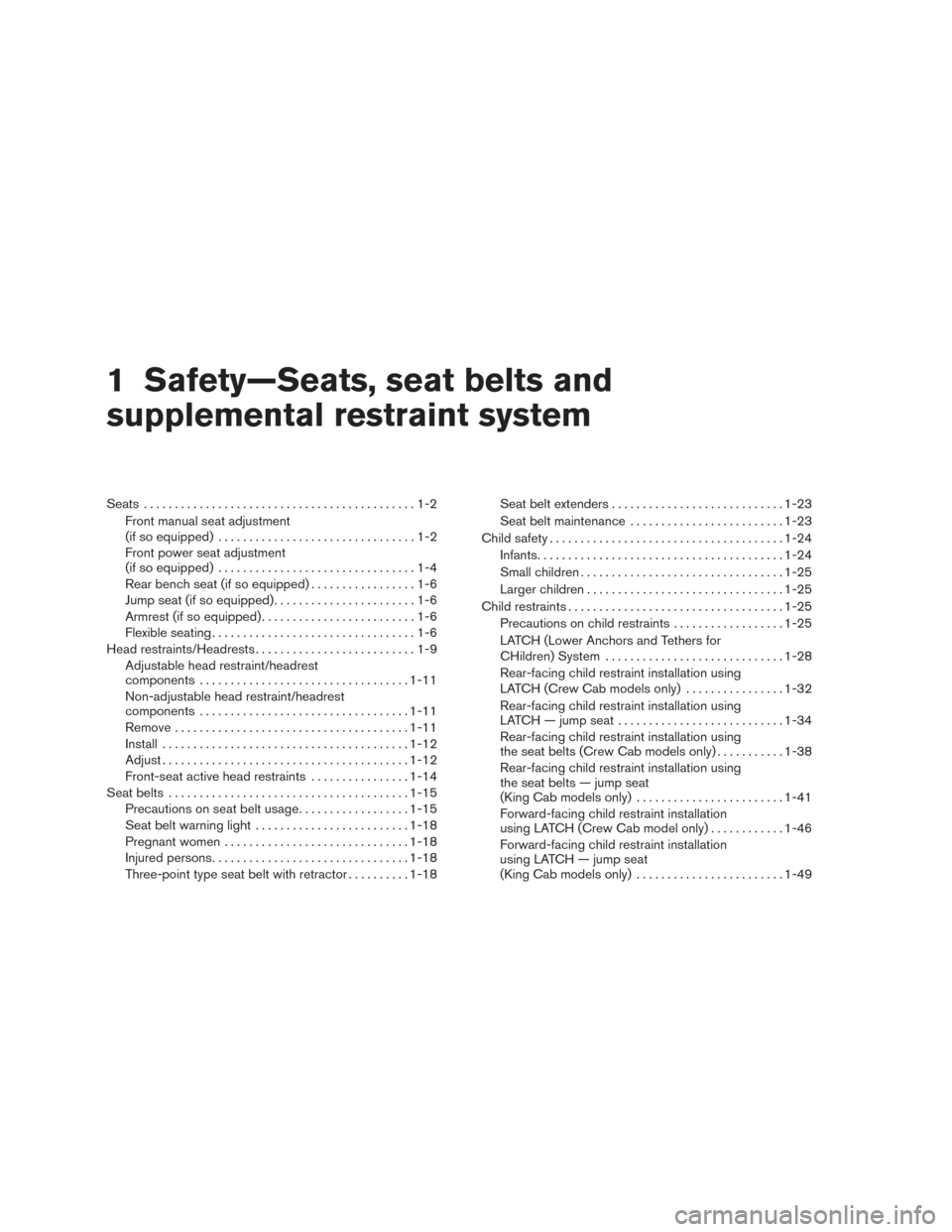
1 Safety—Seats, seat belts and
supplemental restraint system
Seats............................................1-2
Front manual seat adjustment
(if so equipped) ................................1-2
Front power seat adjustment
(if so equipped) ................................1-4
Rear bench seat (if so equipped) .................1-6
Jump seat (if so equipped) .......................1-6
Armrest (if so equipped) .........................1-6
Flexible seating .................................1-6
Head restraints/Headrests ..........................1-9
Adjustable head restraint/headrest
components .................................. 1-11
Non-adjustable head restraint/headrest
components .................................. 1-11
Remove ...................................... 1-11
Install ........................................ 1-12
Adjust ........................................ 1-12
Front-seat active head restraints ................1-14
Seat belts ....................................... 1-15
Precautions on seat belt usage ..................1-15
Seat belt warning light ......................... 1-18
Pregnant women .............................. 1-18
Injured persons ................................ 1-18
Three-point type seat belt with retractor ..........1-18 Seat belt extenders
............................ 1-23
Seat belt maintenance ......................... 1-23
Child safety ...................................... 1-24
Infants ........................................ 1-24
Small children ................................. 1-25
Larger children ................................ 1-25
Child restraints ................................... 1-25
Precautions on child restraints ..................1-25
LATCH (Lower Anchors and Tethers for
CHildren) System ............................. 1-28
Rear-facing child restraint installation using
LATCH (Crew Cab models only) ................1-32
Rear-facing child restraint installation using
LATCH — jump seat ........................... 1-34
Rear-facing child restraint installation using
the seat belts (Crew Cab models only) ...........1-38
Rear-facing child restraint installation using
the seat belts — jump seat
(King Cab models only) ........................ 1-41
Forward-facing child restraint installation
using LATCH (Crew Cab model only) ............1-46
Forward-facing
child restraint installation
using LATCH — jump seat
(King Cab models only) ........................ 1-49
Page 23 of 466
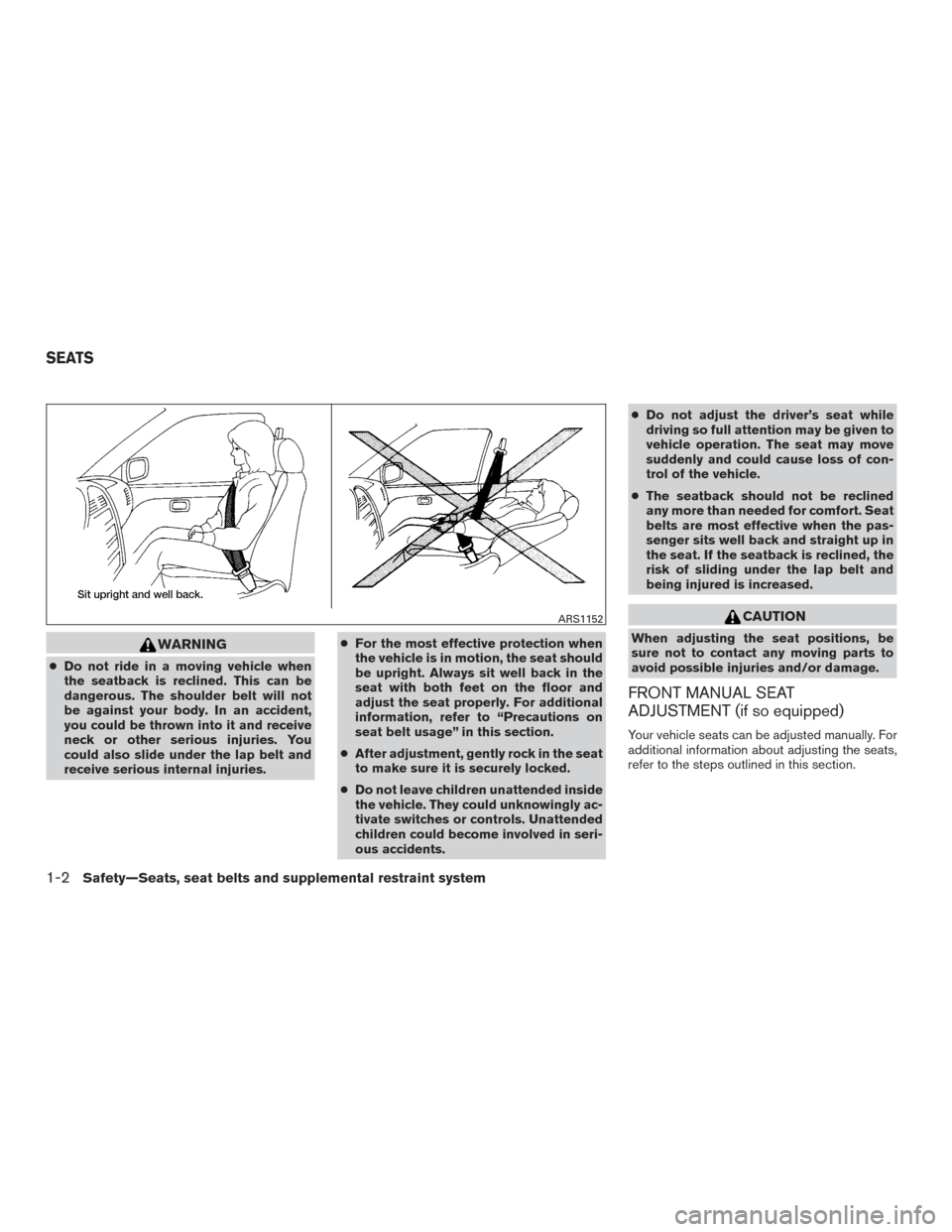
WARNING
●Do not ride in a moving vehicle when
the seatback is reclined. This can be
dangerous. The shoulder belt will not
be against your body. In an accident,
you could be thrown into it and receive
neck or other serious injuries. You
could also slide under the lap belt and
receive serious internal injuries. ●
For the most effective protection when
the vehicle is in motion, the seat should
be upright. Always sit well back in the
seat with both feet on the floor and
adjust the seat properly. For additional
information, refer to “Precautions on
seat belt usage” in this section.
● After adjustment, gently rock in the seat
to make sure it is securely locked.
● Do not leave children unattended inside
the vehicle. They could unknowingly ac-
tivate switches or controls. Unattended
children could become involved in seri-
ous accidents. ●
Do not adjust the driver’s seat while
driving so full attention may be given to
vehicle operation. The seat may move
suddenly and could cause loss of con-
trol of the vehicle.
● The seatback should not be reclined
any more than needed for comfort. Seat
belts are most effective when the pas-
senger sits well back and straight up in
the seat. If the seatback is reclined, the
risk of sliding under the lap belt and
being injured is increased.
CAUTION
When adjusting the seat positions, be
sure not to contact any moving parts to
avoid possible injuries and/or damage.
FRONT MANUAL SEAT
ADJUSTMENT (if so equipped)
Your vehicle seats can be adjusted manually. For
additional information about adjusting the seats,
refer to the steps outlined in this section.
ARS1152
SEATS
1-2Safety—Seats, seat belts and supplemental restraint system
Page 24 of 466
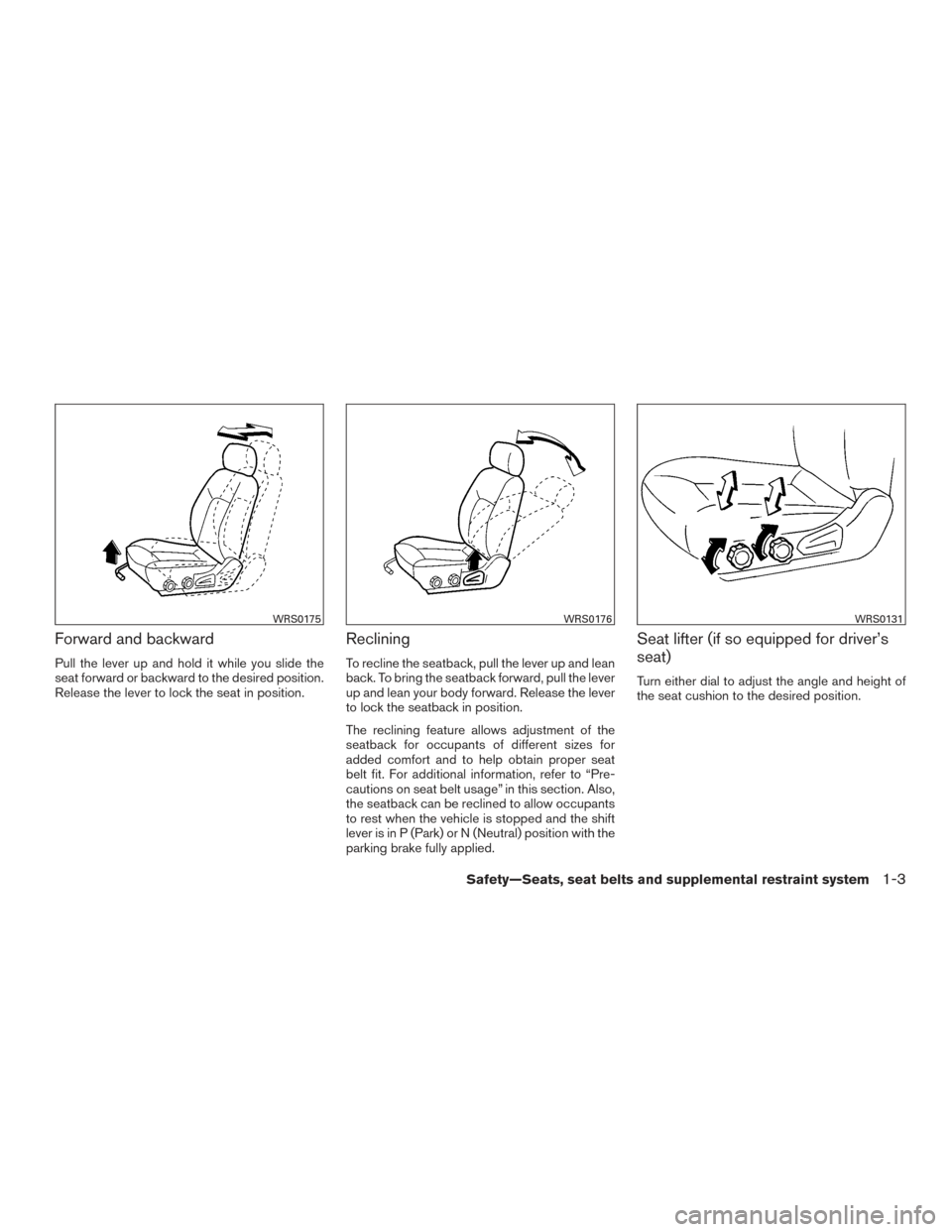
Forward and backward
Pull the lever up and hold it while you slide the
seat forward or backward to the desired position.
Release the lever to lock the seat in position.
Reclining
To recline the seatback, pull the lever up and lean
back. To bring the seatback forward, pull the lever
up and lean your body forward. Release the lever
to lock the seatback in position.
The reclining feature allows adjustment of the
seatback for occupants of different sizes for
added comfort and to help obtain proper seat
belt fit. For additional information, refer to “Pre-
cautions on seat belt usage” in this section. Also,
the seatback can be reclined to allow occupants
to rest when the vehicle is stopped and the shift
lever is in P (Park) or N (Neutral) position with the
parking brake fully applied.
Seat lifter (if so equipped for driver’s
seat)
Turn either dial to adjust the angle and height of
the seat cushion to the desired position.
WRS0175WRS0176WRS0131
Safety—Seats, seat belts and supplemental restraint system1-3
Page 25 of 466
Lumbar support (if so equipped for
driver’s seat)
The lumbar support feature provides adjustable
lower back support to the driver. Move the lever
forward or backward to adjust the seat lumbar
area.
FRONT POWER SEAT ADJUSTMENT
(if so equipped)
Operating tips
●The power seat motor has an auto-reset
overload protection circuit. If the motor
stops during operation, wait 30 seconds
then reactivate the switch. ●
Do not operate the power seat switch for a
long period of time when the engine is off.
This will discharge the battery.Forward and backward
Moving the switch forward or backward will slide
the seat forward or backward to the desired
position.
Reclining
Move the recline switch backward until the de-
sired angle is obtained. To bring the seatback
forward again, move the switch forward and
move your body forward. The seatback will move
forward.
WRS0389WRS0163
1-4Safety—Seats, seat belts and supplemental restraint system
Page 26 of 466
The reclining feature allows adjustment of the
seatback for occupants of different sizes for
added comfort and to help obtain proper seat
belt fit. For additional information,, refer to “Pre-
cautions on seat belt usage” in this section. Also,
the seatback can be reclined to allow occupants
to rest when the vehicle is stopped and the shift
lever is in P (Park) or N (Neutral) position with the
parking brake fully applied.
Seat lifter (if so equipped for driver’s
seat)
Push the front or rear end of the switch up or
down to adjust the angle and height of the seat
cushion.
Lumbar support (if so equipped for
driver’s seat)
The lumbar support feature provides adjustable
lower back support to the driver. Move the lever
forward or backward to adjust the seat lumbar
area.
WRS0164WRS0389
Safety—Seats, seat belts and supplemental restraint system1-5
Page 30 of 466
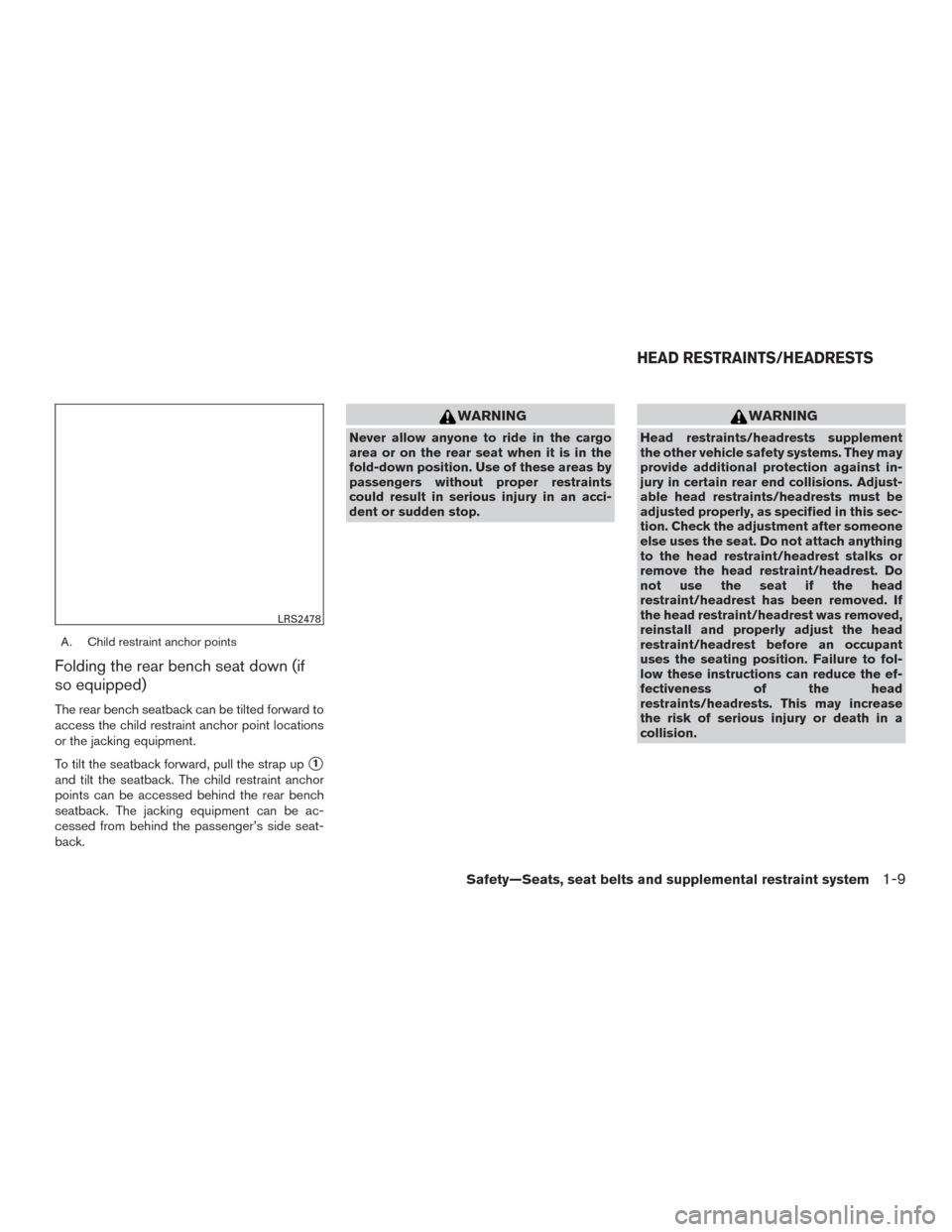
A. Child restraint anchor points
Folding the rear bench seat down (if
so equipped)
The rear bench seatback can be tilted forward to
access the child restraint anchor point locations
or the jacking equipment.
To tilt the seatback forward, pull the strap up
�1
and tilt the seatback. The child restraint anchor
points can be accessed behind the rear bench
seatback. The jacking equipment can be ac-
cessed from behind the passenger’s side seat-
back.
WARNING
Never allow anyone to ride in the cargo
area or on the rear seat when it is in the
fold-down position. Use of these areas by
passengers without proper restraints
could result in serious injury in an acci-
dent or sudden stop.
WARNING
Head restraints/headrests supplement
the other vehicle safety systems. They may
provide additional protection against in-
jury in certain rear end collisions. Adjust-
able head restraints/headrests must be
adjusted properly, as specified in this sec-
tion. Check the adjustment after someone
else uses the seat. Do not attach anything
to the head restraint/headrest stalks or
remove the head restraint/headrest. Do
not use the seat if the head
restraint/headrest has been removed. If
the head restraint/headrest was removed,
reinstall and properly adjust the head
restraint/headrest before an occupant
uses the seating position. Failure to fol-
low these instructions can reduce the ef-
fectiveness of the head
restraints/headrests. This may increase
the risk of serious injury or death in a
collision.
LRS2478
HEAD RESTRAINTS/HEADRESTS
Safety—Seats, seat belts and supplemental restraint system1-9
Page 31 of 466
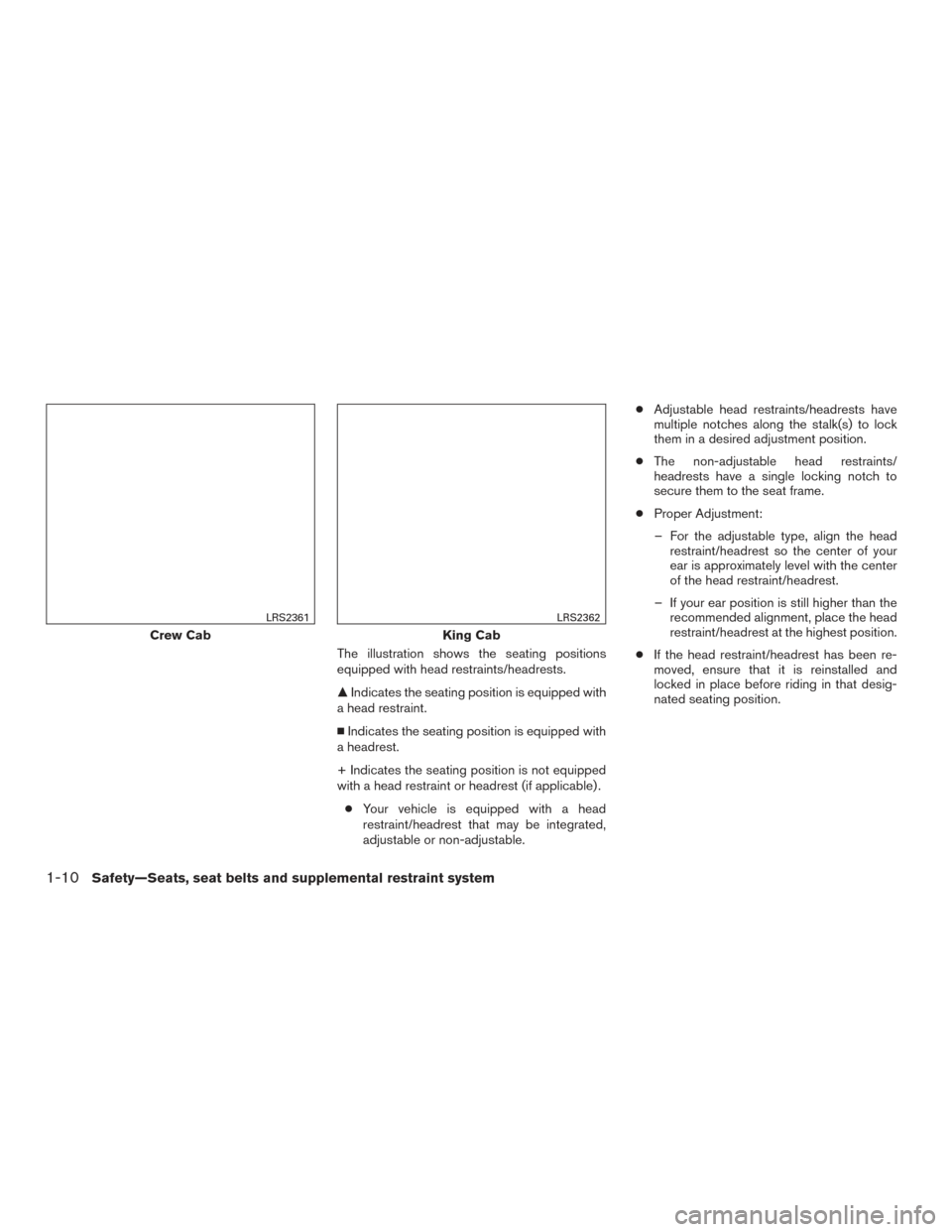
The illustration shows the seating positions
equipped with head restraints/headrests.
�Indicates the seating position is equipped with
a head restraint.
� Indicates the seating position is equipped with
a headrest.
+ Indicates the seating position is not equipped
with a head restraint or headrest (if applicable) .
● Your vehicle is equipped with a head
restraint/headrest that may be integrated,
adjustable or non-adjustable. ●
Adjustable head restraints/headrests have
multiple notches along the stalk(s) to lock
them in a desired adjustment position.
● The non-adjustable head restraints/
headrests have a single locking notch to
secure them to the seat frame.
● Proper Adjustment:
– For the adjustable type, align the head restraint/headrest so the center of your
ear is approximately level with the center
of the head restraint/headrest.
– If your ear position is still higher than the recommended alignment, place the head
restraint/headrest at the highest position.
● If the head restraint/headrest has been re-
moved, ensure that it is reinstalled and
locked in place before riding in that desig-
nated seating position.
Crew Cab
LRS2361
King Cab
LRS2362
1-10Safety—Seats, seat belts and supplemental restraint system